Ann Arbor Hotel First to Get Design Review?
On the evening of Jan. 5, 2011, First Hospitality Group Inc. hosted a citizens participation meeting for the hotel project it’s proposing at the southwest corner of Washington and Division streets. The proposal calls for a 9-story, 104-room, LEED-certified building, facing South Division. The meeting, held at the downtown Ann Arbor District Library, was required by city ordinance – before submitting a site plan for the city to review, developers must invite owners of property within 1,000 feet of a proposed project to a forum that describes the plan.
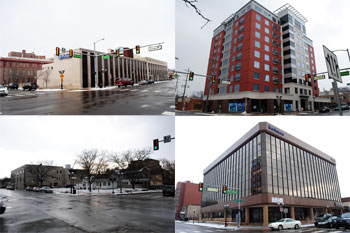
The corners of Washington & Division, clockwise from top left: NW (former Ann Arbor News building); NE (411 Lofts); SE (McKinley's Towne Center); SW (parking lot, site of proposed Ann Arbor Hotel). Image links to larger file.
Much of the conversation between residents and First Hospitality’s Ira Ury revolved around the city’s downtown design guidelines. Even before the meeting, as Ury and resident Ilene Tyler introduced themselves, Tyler wanted to know if First Hospitality had used the design guidelines to develop the schematics on display.
Ury explained that his team had used the draft of the design guidelines that is available on the city’s website. But that draft, which dates from late 2009, has undergone considerable revision since February 2010, when the council appointed a task force to undertake further study and make a recommendation. The task force has been meeting almost weekly for the better part of the past year.
The task force unveiled its draft at a city council work session on Monday, Jan. 10. One key difference between the 2009 draft and the version the task force has now unveiled is the re-introduction of the original design guidelines advisory committee’s October 2007 recommendation for a design review process. It would be a mandatory process overseen by a design guidelines review board, with voluntary compliance by petitioners. But as Ray Detter, president of the Downtown Citizens Advisory Council, put it to Ury on Wednesday, if a developer doesn’t comply with the recommendations of the review board, “Everyone will know!”
Depending on the timing of city council approval of the design guidelines, First Hospitality’s project could be the first site plan that undergoes a formal design guidelines review process. At the council’s work session, Ward 4 councilmember Marcia Higgins said she planned to attach the final draft to the city council’s Jan. 18 agenda as a communications item, and to bring it forward for council approval at the Feb. 7 meeting.
What exactly are these design guidelines? Where did they come from? When might they be approved?
Design Guidelines, Zoning Background
Design guidelines differ from zoning regulations in that zoning regulations typically deal with quantifiable, measurable concepts like building heights and setbacks, while design guidelines involve more subjective judgments like the appropriate use of materials or the pedestrian orientation of a structure. The Chronicle described the difference this way in a September 2009 report on a joint work session of the city council, planning commission and Downtown Development Authority:
Almost every child learns in school that a haiku is a short poem with three lines – lines that adhere to a 5-7-5 syllable count pattern. But only some children learn that not all poems conforming to that 5-7-5 rule are good haikus. For example:
I saw a tower/Looming, stretching really tall/Is it ever high!
Many readers will recognize those lines as a generally failed poem. But what specifically makes it a bad haiku, even though it follows the rule? The first-person narrative, the lack of seasonal referent, the lack of any kind of “aha!” moment – there are any number of ways in which that poetic effort fails to meet basic haiku design guidelines.
Similarly, a proposed new downtown Ann Arbor building that follows a basic height rule of “180 feet maximum” – specified in the zoning regulations – might still be generally recognizable as a poorly-designed building.
Knowing it’s poorly designed is one thing. But it’s another thing for someone to say what exactly makes a building poorly-designed, or in a happier case, well-designed. That requires some knowledge of building design principles – just as critiquing a haiku requires some knowledge of haiku design principles. Perhaps the building’s entrance can’t be easily spotted, or its walls rise in a sheer, windowless face from the sidewalk to its full height.
Mayor John Hieftje began the council’s work session on Monday by saying that sometimes good things take a long time. And in fact, the evolution of the zoning and design guidelines process dates back at least to September 2006, when the Ann Arbor city council approved A2D2 (Ann Arbor Discovering Downtown) as the next step in the Downtown Development Strategies Project. At that point, the project already had a three-year history dating from October 2003. Two of the five priority actions for A2D2 were (i) to overhaul the downtown zoning, and (ii) to establish design guidelines.
Some in the community had supported city council approval of the new A2D2 zoning regulations, only if approval of design guidelines was given at the same time. And in the spring of 2009, the city council appeared ready to approve the zoning package. However, a back-and-forth between the planning commission and the city council – driven largely by questions about the appropriate zoning designation of the South University area – caused a delay.
That delay meant that the original plan – to wrap up the zoning package in late spring 2009, leaving the summer to focus on design guidelines – had to be altered. As zoning regulations stalled in the council from spring through the fall of 2009, the possibility emerged that approval of the design guidelines could re-align itself with the timeframe for approval of zoning regulations.
But the city council gave its final approval to the new zoning regulations in November 2009 without approving the design guidelines. Faced with approving zoning regulations along with design guidelines that included no mandatory review process, the city council decided to proceed with the zoning approval, leaving the design guidelines work to a task force, which it appointed in February 2010. The sentiment among those who strongly supported the concept of design guidelines was that it would be better to delay their approval, if it meant that a mandatory review process could be established, even if compliance would be voluntary.
Design Guidelines, Zoning Timeline
Here’s a timeline overview of the A2D2 zoning and design guidelines work, with links to Chronicle coverage. Also useful is the city planning staff’s documentation of the current task force’s work and the history of prior design guidelines work.
- 2006 Oct. 3: City council appoints design guidelines advisory committee: Christine Crockett (citizen at large), Kurt Brandle (design professional), Ron Emaus (city planning commission), Damian Farrell (design professional), Eric Lipson (city planning commission), Joan Lowenstein (city council), J. Bradley Moore (design professional), Alice Ralph (citizen at large).
- 2008 Nov. 17: Community engagement/briefing by city planning staff on A2D2 plan. ["Feedback Wanted: Downtown Zoning Revisions"]
- 2009 Feb. 19: Planning commission adopts Downtown Plan, assigning all of the South University area to “core” or D-1 zoning.
- 2009 March 3: Planning commission recommends adoption of A2D2 zoning ordinance. ["Planning Commission: 170 Feet for South U."]
- 2009 March 9: City council holds work session on A2D2. ["Council Begins Downtown Zoning Review"]
- 2009 March 23: City council convenes to hear public comment on A2D2. ["A2D2 Zoning in Home Stretch"]
- 2009 April 1: Ann Arbor Downtown Development Authority weighs in against character districts as part of the A2D2 zoning. ["DDA: No Character District Zoning, Please"]
- 2009 April 6: City council amends A2D2 zoning and approves it on first reading in a way that will not allow the council to adopt the Downtown Plan as adopted by the city’s planning commission. Specifically, the council wants a provision for an interface D-2 area in the South U. area. ["City Council Moves Towards Height Limits"]
- 2009 April 20: City council formally votes against adoption of Downtown Plan as adopted by planning commission. Chronicle coverage of April 20, 2009 city council meeting: [link]
- 2009 May 12: Planning commission convenes work session to contemplate possible revision to Downtown Plan. ["What's Your Downtown Plan?"]
- 2009 May 19: The planning commission allows a D-2 interface area in South University, but it’s smaller than the D-2 area approved by the city council. ["Planning Commission Draws Line Differently"]
- 2009 June 15: City council approves Downtown Plan with smaller D-2 interface district. ["City Place Delayed, Downtown Plan OK'd"]
- 2009 July 6: City council postpones A2D2 zoning as first reading item. Chronicle coverage of July 6, 2009 city council meeting: [link]
- 2009 July 20: City council again postpones A2D2 zoning as first reading item. Chronicle coverage of July 20, 2009 city council meeting: [link]
- 2009 Sept. 8: City council approves A2D2 zoning approved at first reading. [''City Council Begins Transition"]
- 2009 Sept. 14: Joint work session held by city council, planning commission, DDA. ["Downtown Design Guides: Must vs. Should"]
- 2009 Oct. 4: City council discusses design guidelines at Sunday caucus. ["Another Draft of Downtown Design Guides"]
- 2009 Oct. 5: City council holds public hearing on design guidelines at its regular meeting. ["Mandatory Process Likely for Design Guides"]
- 2009 Oct. 6: City planning commission recommends adoption of design guidelines.
- 2009 Nov. 15: City council discusses guidelines at Sunday caucus. ["Zoning, Design Guides on Council's Agenda"]
- 2009 Nov. 16: City council gives final, second-reading approval to A2D2 zoning. Holds public hearing on design guidelines. ["Downtown Planning Process Forges Ahead"]
- 2010 Jan. 19: A2D2 steering committee dissolved. Members were Marcia Higgins (city council), Roger Hewitt (DDA board), Evan Pratt (planning commission).
- 2010 Feb. 1: City council appoints A2D2 design guidelines task force [Chronicle report of the Jan. 31: 2010 city council caucus] Members are: Marcia Higgins (city council), Kirk Westphal (planning commission), Tamara Burns, Bill Kinley, Richard Mitchell, Peter Pollack, Norm Tyler.
- 2010 Nov. 15: City council extends Dec. 6, 2010 deadline for design guidelines task force to complete its work. Chronicle report of the Nov. 15, 2010 city council meeting: [link]
City Council Work Session: Design Guidelines
At the Jan. 10, 2011 city council work session, held at Community Television Network studios on South Industrial Highway, members of the task force unveiled the latest draft of the design guidelines, which task force member Norm Tyler said the group considers finished.
At their next Wednesday meeting, which the task force expects will be its final gathering, members hope to flesh out the role and timing of the design board review process as it relates to other elements of a site plan review.
Three of the task force members besides Marcia Higgins (Ward 4) addressed the city council at its work session: Norm Tyler, an urban planning professor in Eastern Michigan University’s department of geology and geography; Tamara Burns, a local architect with HopkinsBurns Design Studio, and Bill Kinley, founder of Phoenix Contractors.
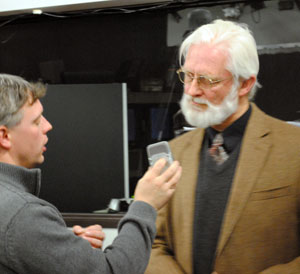
After the Jan. 10 city council work session, Andrew Cluley of WEMU radio inteviews Norm Tyler, a member of the design guidelines task force.
Tyler led off by introducing much of the history of the document that they’d started with – the draft from September 2009. He said the task force set about to simplify and to clarify. He described how the task force undertook a major simplification. They didn’t want any fluff, or commentary on how beautiful the world is. Each sentence was subjected to the test: Does this sentence tell an architect what to draw on a page?
The task force’s document consists of two chapters. Chapter one contains the general design guidelines, divided into three levels: (1) context and site planning, (2) buildings, and (3) building elements. Tyler introduced the council to examples of guidelines from each of those categories. From the context and site planning category:
Pedestrian walkways should be well integrated with existing infrastructure in a way that supports pedestrian connections within and outside the areas of the proposed project.
From the building category:
When a new building will be larger than surrounding structures, visually divide it into smaller building modules that provide a sense of scale.
From the building elements category:
Clearly define a primary entrance and orient it toward the street.
Any guidelines, said Tyler, are confined to the first chapter. This is a difference between the current task force draft and the earlier one, which attempted to specify design guidelines for each of eight different character districts within downtown Ann Arbor: South University, State Street, Liberty/Division, East Huron, Midtown, Main Street, Kerrytown, and First Street.
The eight character districts appear in the second and final chapter of the task force draft. In that chapter, the task force has tried to introduce the reader to what makes each of the character districts unique. South University, for example, is typified by its diversity. Midtown is described as a civic corridor.
Other ways the task force draft is different from the earlier version include: only good examples are illustrated; only photographs from Ann Arbor are included; discussion of material already in the zoning ordinance has been eliminated; and recommendations on a design review board have been developed, which would fit into the existing site plan review process used by the city.
Tamara Burns gave some of the rationale and benefits for having a design review board. They include the fact that a design review that comes early in the process will provide early feedback to a project’s design team. As an architect, she said that the field had evolved away from a “master builder” model to a more collaborative team-based process. Feedback from a city design review board would fit into that culture, she said. Members of the design review board would have design expertise, and their process would be open to the public, she said.
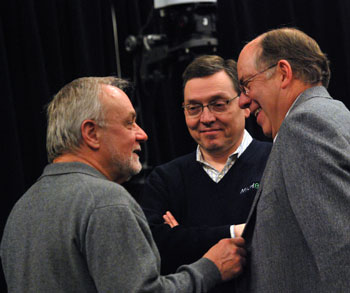
Left to right: Bill Kinley, member of the design guidelines task force; Stephen Rapundalo (Ward 2); and Roger Fraser, city administrator.
Following Burns, Bill Kinley stressed that the design review board process would not, however, be simply another opportunity to have another “bite at the apple.” The public would have ample opportunity to weigh in during the public hearings held by the planning commission and the city council as part of any site plan review, as well as at the required citizen participation meeting.
Kinley read aloud a statement written by local architect Richard Mitchell, a task force member who was not present at the work session. Mitchell’s sentiments reflected his belief that the vast majority of developers are looking for a long-term investment in the community and aim to create something that will be a source of pride for the community. Getting early advice from the design review board, which would have insight into a particular building location and its context, would be valuable.
During council discussion, Christopher Taylor (Ward 3) wanted to know what the rationale was behind the mandatory process but voluntary compliance associated with the recommendations of the design review board. Tyler explained that they did not want to make the design review a regulatory process, which it would become if compliance with its recommendations were mandatory. Taylor wanted to know if there were other examples of a mandatory/voluntary scheme, and Tyler told him that Seattle and Boulder had such systems and were successful.
Carsten Hohnke (Ward 5) said he trusted that the goal in identifying design guidelines was to identify enduring principles as opposed to reflecting fads. But he wanted to know what the process would be by which the guidelines would be reviewed. Higgins told Hohnke that the guidelines would be reviewed annually.
Tony Derezinski (Ward 2) asked if the design board’s review process would apply to planned unit developments (PUDs) as well as matter-of-right projects. Yes, said Higgins. She mentioned in her concluding remarks that the draft they’d shown to members of the community had received a positive response.
One issue that seems likely to be the focus of the task force’s final meeting on Wednesday is where exactly the design board’s review process will fit into the site plan review timetable that is currently in place. Higgins indicated that it would likely be just before the required citizen participation meeting or concurrently with it.
Citizen Participation Meeting: First Hospitality
The two representatives of First Hospitality who introduced the Ann Arbor Hotel project to residents at last Wednesday’s citizen participation meeting were director of business development Ira Ury, as well as president and chief operating officer Bob Habeeb.

Ira Ury, director of business development for First Hospitality Inc., hosted the citizen participation meeting last Wednesday for the proposed Ann Arbor Hotel on South Division. (Photos by the writer.)
Ury gave a brief introduction to First Hospitality, which has been in the hotel business for 26 years, he said. Headquartered in the Chicago area, they currently manage and operate 4o hotels in the Midwest. Their first hotel was a Hampton Inn in Bloomington, Ind., built in 1985, so they have experience building, owning and operating hotels in midwestern college towns, he said, including a Hampton Inn in Ann Arbor. He stressed that First Hospitality is not a real estate development company, but rather an owner/operator of nationally franchised hotels.
The proposed project, Ury said, would be a 9-story, 104-room, LEED-certified hotel with an outdoor plaza. At the fourth floor, there would be a 5-foot stepback, pulling the building back from the lot lines. The entrance would face South Division Street. Habeeb described how the use of a mix of building materials and the stepback design had resulted in a handsome building, although he allowed that the black-and-white rendering made it difficult to see.
Attendees of the meeting drew out additional information. The project was based on a business decision that a hotel would be viable there. The city of Ann Arbor would not be financially liable – First Hospitality is investing its own money. The level of LEED certification is planned to be at least Gold.
Ury allowed that hotel occupancy in the area might be 60%, but that reflects an average – there are some hotels that are currently at 80%, he said. A nationally franchised hotel would add value to downtown Ann Arbor, he said. Hotels are in and of themselves community centers, he noted.
Some attendees seemed skeptical that there would be an adequate market for a downtown hotel. Who would stay there? Ury and Habeeb described a range of guests, from business travelers to University of Michigan visitors. Ury said their project was not connected to proposals for the city-owned Library Lot, which include a hotel and conference center. He did not think that a 104-key hotel would do a lot of group business, though he expected they would have a positive and collegial relationship with any hotel that might be built on the Library Lot, a parcel located on South Fifth Avenue. The city is exploring proposals for developing a project on top of an underground parking structure being built there.
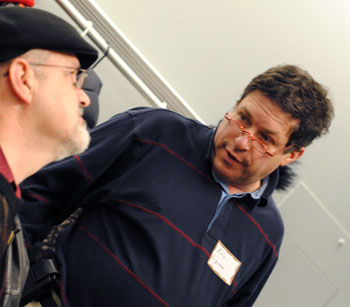
At left is architect Brad Moore, chatting with Eric Lipson, a former planning commissioner. The two were members of the original A2D2 design guidelines advisory committee. They attended the Jan. 5 citizens participation meeting on the Ann Arbor Hotel.
Attendees expressed concern about the impact on the traffic pattern on Division Street. By way of background, a previous PUD (planned unit development) proposal for a hotel at the same location had been rejected by the Ann Arbor city council on Jan. 22, 2008. The decision was based at least in part over concerns that cars exiting the hotel would need to cross two lanes of traffic to make a right turn onto Washington Street, in order to park at the Liberty Square parking structure. One difference between then and now are the bump-outs that have been installed along Division Street as part of the Fifth and Division streetscape project that the DDA has nearly completed. The 2008 proposal had divided the city planning commission on a 4-4 vote.
Ury said they would do the required traffic study. There would be a self-park option as well as a valet option. Valets would be trained to proceed correctly to the parking structure, not cutting across several lanes of traffic. There would be 44 spaces in the Liberty Square structure reserved for the hotel.
There is currently not a plan for retail or a restaurant on the ground floor, Ury said. Responding to that part of the proposal, Roger Pothus – whose clothing store Renaissance is located on Division across the street from the proposed hotel – suggested that the hotel should be built a couple stories taller, so that some kind of use besides a hotel lobby could be considered for the ground floor.
The sentiment expressed by Pothus was echoed by Ward 1 city councilmember Sabra Briere, who allowed that she might be labeled a heretic for saying so. She noted that on occasion when she traveled, she had stayed in hotels with their lobbies on the second floor. She told Ury that he had 180-feet – alluding to the maximum height limit in the D-1 zoned district where the hotel is proposed. She told him that the input from the meeting and from the design board in the future was not meant to destroy the project, but to make it better.
Attendees pressed Ury about whether the project would incorporate the city’s new design guidelines. Ury assured them that First Hospitality would consider any new guidelines adopted by the city and, if necessary, adapt their design to those standards.
There has not been a final decision about which national franchise the hotel would operate under, Ury said, and there would be “trade dress” items for the building required by different franchises. There is flexibility within those trade dress items, however, and the city would ultimately decide the issue. Asked by attendees what materials they had in mind for the building, Ury said they would be high quality materials, quipping that it would not be made of cardboard.
Much of the design critique from attendees focused on the north side of the building, where the design indicates that a plaza will be located. The feedback was that it needs to be more clearly defined as an alternative entrance and needs generally to be made more transparent – with additional windows. Pothus fully supported the idea of some kind of micro-plaza, giving as an example the area just south west of Main Street along William Street’s north side, near where his clothing store was formerly located.
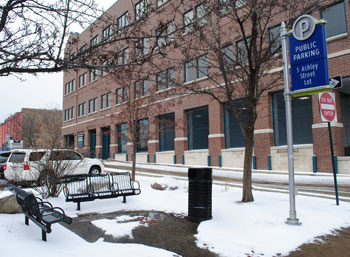
Just west of Main Street on William are these two benches and a trash can that Roger Pothus described as one of Ann Arbor's smallest but most densely used parks. His comments came in support of the idea of a micro-plaza in connection with the proposed Ann Arbor Hotel on South Division.
Ray Detter suggested that the black-and-white schematic looked like the building at Washington & State that “everyone hates.” Detter was referring to the Cornerhouse Lofts building, commonly known as the Buffalo Wild Wings building. Karl Pohrt, owner of the former Shaman Drum Bookshop on South State, once described the building in an interview as “butt ugly.”
As the meeting concluded, attendees expressed the hope that there would be an additional citizens participation meeting, at which more detailed colored schematics would be available. They gave the meeting held last year by Zaragon Place II as an example of the level of detail they were hoping for.




“Ray Detter suggested that the black-and-white schematic looked like the building at Washington & State that “everyone hates.””
Not sure if ‘universal love’ is a requirement of the new guidelines. You want to talk about universal hatred though, just wait for the new water fountain at the Courts-Police building thta Mr. Detter was a cheerleader for. I do know from dealing with the folks at the Ann Arbor Hampton operation that this company is first class, their business is first rate and customer friendly and this hotel would be a welcome addition for downtown. And I no one is asking me for tax dollars to build it. What a novel concept.
Great corner photos; they get to the heart of the matter. We don’t need a second big blank wall at this intersection. I hope First Hospitality takes a look.
The article I mentioned at the meeting, about windows getting punched in a blank wall at an important corner nearby, can be found here: [link]
I’m having trouble locating the place in the photo, and “south of Main Street along William Street’s north side” isn’t helping. West of Main Street? Is this between the parking lot exit and the alley on William? I would like to visit this little parklet (hopefully in a warmer time).
Re: [3] “I’m having trouble locating the place in the photo, and ‘south of Main Street along William Street’s north side’ isn’t helping. West of Main Street?”
Yes, it should read “west of Main Street.”
Ray Detter “personifies” everything that I love about downtown Ann Arbor. We stray from his wisdom and insights at our peril.
~Stew
I hope that the proposed hotel, if this plan comes to fruition, will have a number of accessible rooms with accommodations for individuals with disabilities. Right now, those are few and far between in the downtown area.
I think Ann Arbor could easily support a downtown hotel. I’ve helped organize a few meetings and always had trouble getting a block of rooms at the Campus Inn. At least once I’ve had to put people on the edge of town when I would much rather have had them in the center. And the Campus Inn isn’t really what I think of as downtown.
The description of an ugly building having blank walls and no obvious entrance made me think of the new addition to City Hall.
Maybe, that blank wall can have a mural on it or some sort of long banner like the building one sees from Comerica Park. [link]
The reason I suggest that this is a banner is that that I’ve seen more than one image there over the years: aquarium image, and Verizon “Can you hear me?” man.